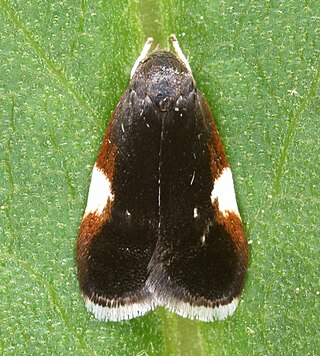
Helcystogramma is a genus of moths in the family Gelechiidae. The genus was erected by Philipp Christoph Zeller in 1877.

Hellinsia inquinatus is a moth of the family Pterophoridae. It is found in North America, including Florida, Mississippi, Oklahoma, Tennessee, Maryland, Alabama, Texas, Missouri, Colorado and Arizona. It has also been recorded from Hispaniola, Mexico, Puerto Rico and St. Thomas Island.

Helcystogramma convolvuli, the sweet potato moth, sweetpotato webworm moth, sweetpotato leaf roller or black leaf folder, is a moth of the family Gelechiidae. It is mainly found in Asia and Africa, but there are also records from Oceania, the Middle East, the Caribbean and Florida in the United States. The species is also found on the Canary Islands and Madeira.
Ostrinia obumbratalis, the smartweed borer, is a moth in the family Crambidae. It was described by Julius Lederer in 1863. It is found in North America, where it has been recorded from New Brunswick and Manitoba to Louisiana and Florida.

Frechinia helianthiales is a moth in the family Crambidae. It was described by Mary Murtfeldt in 1897. It is found in North America, where it has been recorded from Arizona, Illinois, Manitoba, Missouri and Oklahoma, south to Mexico.
Frechinia laetalis is a moth in the family Crambidae. It was described by William Barnes and James Halliday McDunnough in 1914. It is found in North America, where it has been recorded from eastern Washington and Oregon to Utah, southern California and western Texas.

Metalectra tantillus, the black fungus moth, is a moth of the family Erebidae. The species was first described by Augustus Radcliffe Grote in 1874. It has been recorded from the US states of Alabama, Florida, Georgia, Illinois, Iowa, Kentucky, Maryland, Mississippi, New Jersey, North Carolina, Ohio, Oklahoma, Pennsylvania, South Carolina, Tennessee, Texas, West Virginia and Wisconsin.

Ponometia candefacta, the olive-shaded bird-dropping moth, is a moth of the family Noctuidae. It is found in North America, where it has been recorded from the northern United States to southern Mexico. It has been introduced to Russia as a biological control agent of Ambrosia artemisiifolia. The habitat consists of dry, weedy, disturbed areas at low elevations.
Epermenia pimpinella is a moth in the family Epermeniidae. It was described by Mary Murtfeldt in 1900. It is found in North America, where it has been recorded from South Carolina, Ohio, Illinois, Arkansas and Oklahoma.

Dichomeris juncidella is a moth in the family Gelechiidae. It was described by James Brackenridge Clemens in 1860. It is found in North America, where it has been recorded from Nova Scotia, southern Quebec and southern Ontario to Florida, Texas and Nebraska.
Helcystogramma badia is a moth in the family Gelechiidae. It was described by Annette Frances Braun in 1921. It is found in North America, where it has been recorded from California and Nevada to southern British Columbia and Utah.
Helcystogramma casca is a moth in the family Gelechiidae. It was described by Annette Frances Braun in 1925. It is found in North America, where it has been recorded from southern Saskatchewan and British Columbia to Utah, Colorado and Oregon.
Helcystogramma ectopon is a moth in the family Gelechiidae. It was described by Ronald W. Hodges in 1986. It is found in North America, where it has been recorded from Nebraska and Mississippi.
Helcystogramma fernaldella, or Fernald's helcystogramma moth, is a moth in the family Gelechiidae. It was described by August Busck in 1903. It is found in North America, where it has been recorded from Alaska, Yukon and Alberta, east across Canada and the northern United States to New Brunswick and New England. The habitat consists of fields, meadows and grasslands.

Helcystogramma melanocarpa is a moth in the family Gelechiidae. It was described by Edward Meyrick in 1929. It is found in North America, where it has been recorded from Nova Scotia to New Brunswick to South Carolina and to Texas.
Helcystogramma melantherella is a moth in the family Gelechiidae. It was described by August Busck in 1900. It is found in North America, where it has been recorded from North Carolina south to Florida and west to Texas and Arkansas.
Keiferia inconspicuella is a moth in the family Gelechiidae. It was described by Mary Murtfeldt in 1883. It is found in North America, where it has been recorded from the south-eastern and mid-western United States, north to New Jersey and Iowa and west to Nebraska and Texas.
Gnorimoschema saphirinella is a moth in the family Gelechiidae. It was described by Vactor Tousey Chambers in 1875. It is widespread throughout North America, where it has been recorded from Alabama, Arizona, California, Colorado, Florida, Georgia, Illinois, Kansas, Mississippi, New Mexico, North Dakota, Oklahoma, Tennessee and Texas.

Symmetrischema striatella is a moth in the family Gelechiidae. It was described by Mary Murtfeldt in 1900. It is found in North America, where it has been recorded Alabama, Arkansas, California, Florida, Illinois, Louisiana, Maine, Maryland, Mississippi, Missouri, New Jersey, Oklahoma, South Carolina, Tennessee and Texas. This species has also been accidentally introduced to New Zealand.

Menesta melanella is a moth in the family Depressariidae. It was described by Mary Murtfeldt in 1890. It is found in North America, where it has been recorded is the states: Alabama, Arizona, Florida, Kentucky, Massachusetts, Mississippi, Missouri, New Jersey, North Carolina, Ohio and South Carolina.








